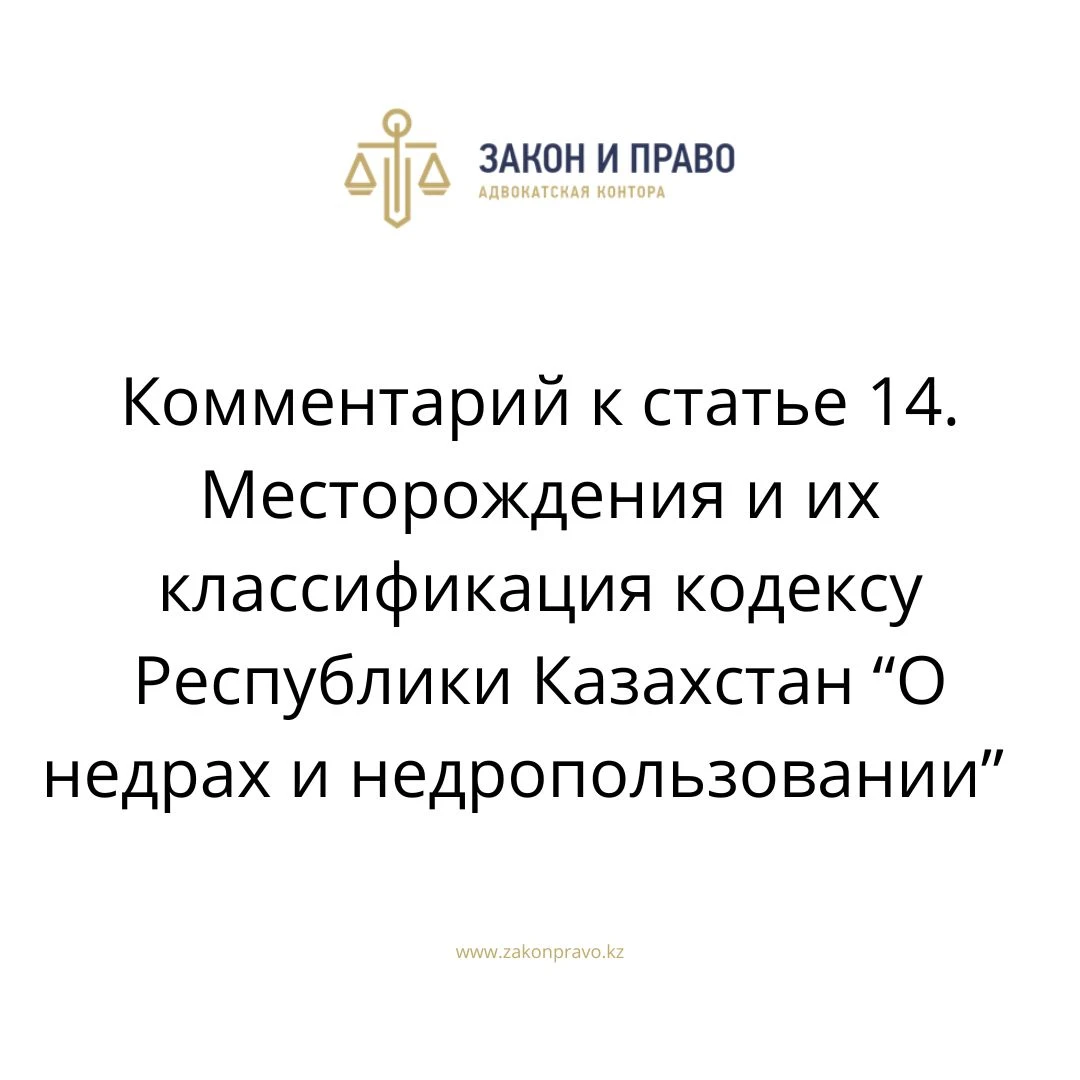Commentary to Article 14. Deposits and their classification to the Code of the Republic of Kazakhstan “On Subsoil and Subsoil Use”
1. A deposit is a natural or man-made accumulation of a mineral (minerals), which, by its quantitative, qualitative and mining characteristics, may be suitable for industrial development with a positive economic effect.
2. According to the size of resources or reserves of minerals and their economic significance, large deposits are allocated to a separate category.
3. Deposits of solid minerals containing the following resources are recognized as large:
Mineral resource, unit of measurement Quantity
Iron ores, million tons >100
Manganese ores, million tons >50
Chromite ores, million tons >30
Copper, million tons >5
Lead, million tons >5
Zinc, million tons >5
Bauxite, million tons >50
Nickel, thousand tons >50
Tungsten, thousand tons >100
Molybdenum, thousand tons >200
Gold, t >250
Coking coal, million tons >50
Energy coal, million tons >500
Brown coal, million tons >500
Oil shale, million tons >500
Phosphorites (ore), million tons >200
Sulfuric acid, mixed potassium salts, million tons >100
Hydrocarbon deposits containing the following geological reserves are considered large:
Mineral resource, a unit of measurement Quantity
Oil, million tons >100
Natural gas, billion m3 >50
______________________________________________________________________________________
(Mukhamedov R.N.)
1. Paragraph 1 of the commented article contains a general definition of the concept of "deposit", which should be applied taking into account other provisions of the legislation on subsoil.
With regard to hydrocarbon deposits, it is necessary, in particular, to keep in mind the important requirements provided for in the Special Part of the Subsoil Code, primarily in paragraph 2 of Article 121 of the Subsoil Code.
Based on the meaning of paragraphs 1 and 2 of Article 121 of the Subsoil Code, hydrocarbon deposits, within the meaning of paragraph 1 of the commented article, refer to natural accumulations of minerals.
In turn, the criterion of man-made accumulations of minerals, also mentioned in paragraph 1 of the commented article, refers to the provisions of art. 13 of the Subsoil Code.
Suitability for industrial development with a positive economic effect in relation to hydrocarbon deposits is determined within the framework of the state expertise of the subsoil (see Article 141 of the Subsoil Code), which examines the relevant reports on the calculation (operational calculation) of mineral reserves.
At the same time, the operational calculation of reserves is carried out after the completion of the assessment of the discovered hydrocarbon deposits, and the "final" calculation of reserves is carried out after the completion of exploration and before the transition to the production stage or the preparatory period (see, in particular, paragraph 4 of art. 139, paragraph 4 of art. 118 of the Subsoil Code).
2. For the concepts of "minerals" and "oil", see Article 12 of the Subsoil Code. The definition of the concept of "natural gas" is not established by the Subsoil Code.
3. The definition of hydrocarbon deposits as oil, gas oil, oil and gas, oil and gas condensate, gas or gas condensate - is carried out, in particular, according to the rules of paragraph 11 of the EPRKIN.
4. The gradation of deposits depending on the size of reserves in order to establish differences in the conditions and regulation of subsurface use was also carried out within the framework of the 2010 Law on Subsurface Resources, however, the immediate
There were no criteria for classifying deposits as large or unique. This issue was resolved within the framework of the Instructions on the Classification of reserves of deposits, prospective and forecast resources of oil and natural hydrocarbon gas (which has not been terminated to the present), Appendix 2 to which establishes the following criteria:
Field classes by recoverable reserves oil+condensate million tons gas billion m3
Gigantic more than 300 more than 300
largest 100.1 -300 100.1 -300
large ones 30,1-100 30,1-100
average 10.1 -30 10.1 -30
small 3,1-10 3,1-10
small 1-3 1-3
Very small up to 1 up to 1
Thus, the specified instructions contain criteria for large deposits, but they are not unique (in all likelihood, the largest and giant deposits can be classified as unique).
In turn, within the framework of the commented article of the Subsoil Code, criteria were established for classifying hydrocarbon deposits as large, which at the same time operate on the amount of geological reserves rather than recoverable reserves, which is related to the planned reform of reserves reporting starting in 2024, reflected in the transitional provisions of the Code. However, the criteria for uniqueness (despite the use of this term and within the framework of the Code on Subsoil) are still not established.
Constitution Law Code Standard Decree Order Decision Resolution Lawyer Almaty Lawyer Legal service Legal advice Civil Criminal Administrative cases Disputes Defense Arbitration Law Company Kazakhstan Law Firm Court Cases
Kazakh Association of Organizations of the Oil and Gas and Energy Complex KAZENERGY
Nur Sultan 2022
The Kazenergy Association expresses its sincere gratitude for the support in preparing the commentary to the following companies: North Caspian Operating Company NV, NC KazMunayGas JSC, Mangistaumunaygas JSC, Karachaganak Petroleum Operating BV, White & Case Kazakhstan LLP, Haller Lomax LLP)", "Erlicon CG" LLP, "Signum Law Firm" LLP. © Kazenergy Association, 2022 © team of authors, 2022 © authors, 2022
Dear readers!
We offer you a scientific and practical commentary prepared by a group of Russian specialists with extensive practical experience in legislation on subsoil and subsoil use and who participated in the preparation of the Code on Subsoil and Subsoil Use.
Subsurface use is a very complex and specific area of public relations, the regulation of which has its own historical background and takes into account the technological specifics of the process of subsurface development, as well as environmental, commercial, legal and other features of exploration and development of deposits.
Kazakhstan's legislation on subsoil and subsurface use has passed through several stages in its development, and has always been based on a balance of interests between the state and subsurface users, transparency, striving for the maximum possible degree of protection of the rights and legitimate interests of investors, ensuring sustainable social, economic and environmental development of the country.
The Code "On Subsoil and Subsoil Use", adopted at the end of 2017, was developed taking into account many years of accumulated experience and law enforcement practice, as well as the results of extensive discussions with experts working in the industry.
It reflects specific, important measures on the part of the state to increase the investment attractiveness of exploration and further reduce administrative barriers.
Nevertheless, practice and legislation do not stand still, constantly evolving, taking into account new challenges facing both the subsurface use industry and the economy as a whole.
In this regard, this commentary is intended to serve as an aid for a wide range of interested persons – specialists working in the industry, in
understanding the meaning of the norms, their historical context, the interrelationship and mutual influence of the various provisions of the Code.
We also hope that studying the commentary will serve as an incentive for new generations of young domestic specialists to work scientifically and practically in this important industry, for the benefit of the development of our country, current and future generations of Kazakhstanis.
Sincerely, U. Karabalin, Deputy Chairman of the Kazenergy Association, Hero of Labor of Kazakhstan


